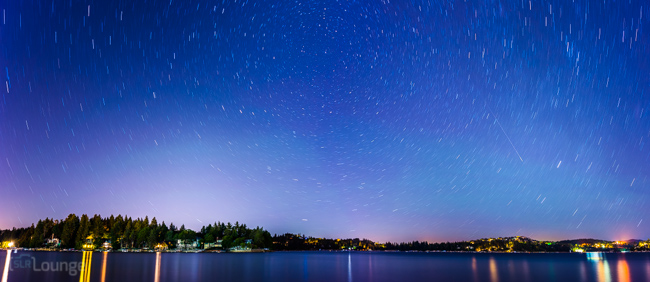
For those of you who don’t know, (and for those of you in the Northern Hemisphere) the Perseid meteor shower is coming in one week. (August 11th-13th) Are you ready to photograph some meteors? Shooting stars are a pretty tricky and elusive photographic subject, so we created this tutorial video to help you out.
For more reading information on the Perseids, visit the website “Universe Today” here…
Images
 (Click HERE for a larger version!) Lake Arrowhead, CA, Aug. 2013
(Click HERE for a larger version!) Lake Arrowhead, CA, Aug. 2013
Two 450 sec. exposures @ f/2 & ISO 200, Nikon D7100, Rokinon 16mm f/2, Oben Tripod
 15 sec. star exposure plus 1 hr worth of satellites and meteors
15 sec. star exposure plus 1 hr worth of satellites and meteors
Nikon D7100, Rokinon 16mm f/2, Oben Tripod
 Very large meteor “green fireball” (green is a very common color for meteors!)
Very large meteor “green fireball” (green is a very common color for meteors!)
(LASERS! No, not the evil weapon kind- click here to read about Adaptive Optics)
(Image (c) Sean Goebel, click here for Mauna Kea pics)
40 sec @ f/2 & ISO 4000, Canon 5D mk2, Rokinon 35mm f/1.4, tripod
 A close-up of what a meteor looks like: A single, long tail
A close-up of what a meteor looks like: A single, long tail
 A close-up of what an Iridium satellite flare looks like. (click HERE to read more!)
A close-up of what an Iridium satellite flare looks like. (click HERE to read more!)
 Here is what ~90 mins of stacked star images looks like.
Here is what ~90 mins of stacked star images looks like.
…At f/5.6 however, meteors are nearly impossible to see.
Additional Tips
- Get away from light pollution!
Head to the desert, the mountains, anywhere away from the city. (If that’s where you live.) Minimizing light pollution and reducing the overall atmosphere are your best friends when you’re trying to get a clear view of the night sky. If you live in Southern California, my favorite places to go within a ~2-3 hr drive are Arrowhead Lake, and Joshua Tree National Park. - Get yourself a rock-steady tripod…
It goes without saying, but you gotta lock it down! Often when you head away from your nice calm suburban home, you find that your optimal viewing location is windy at night, especially if you’re on a mountain peak or in the high desert. - Check your histogram! don’t be fooled by your LCD.
In the pitch-black of your remote viewing location at 1 AM, the back of your camera LCD will seem painfully bright to your eyes. It is very common for this issue to lead to vastly under-exposed images in post-production, so be sure to ONLY trust your histogram. (most light meters are going to be completely wrong at night, especially during a new moon.) - Memorize your lens’ perfect focus setting for sharp stars!
The awesome thing about photographing stars is that they’re always the same distance away- infinity! Start by setting your focus to the infinity mark on your lens, and then take test photos. Each lens has slightly different characteristics, so perfect sharpness for stars may be just to the left or right of infinity, actually. But once you memorize that exact spot, you can easily check focus throughout the night. (Unfortunately however, dramatic temperature changes may affect this setting.)
More about the 2013 Perseids
- The Perseid meteors can fill the entire night sky at times, however they will emanate from the point just to the lower-right of the North Star. (As seen in the panoramic image above)
- This year’s Perseid meteor shower will peak at 13:00 UT (5 AM Pacific Time) for the Hawaii / North American west-coast area, and then again at 2:00 UT for Europe.
- The moon will not be in the night sky during the nights of the Perseid’s peak on the 11th-13th, making this year potentially extra-spectacular!
- To view previous Perseid / meteor shower images, check out this search on Flickr!
Matthew Saville
Follow his wilderness nightscape adventures on Instagram: instagram.com/astrolandscapes




Get Connected!